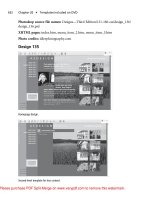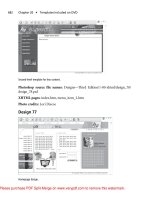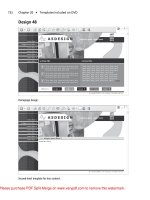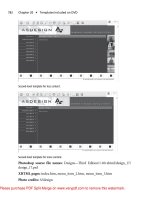Mixed-signal and DSP Design Techniques pdf
Bạn đang xem bản rút gọn của tài liệu. Xem và tải ngay bản đầy đủ của tài liệu tại đây (3.95 MB, 424 trang )
MIXED-SIGNAL AND DSP
DESIGN TECHNIQUES
INTRODUCTION SECTION 1
SAMPLED DATA SYSTEMS SECTION 2
ADCs FOR DSP APPLICATIONS SECTION 3
DACs FOR DSP APPLICATIONS SECTION 4
FAST FOURIER TRANSFORMS SECTION 5
DIGITAL FILTERS SECTION 6
DSP HARDWARE SECTION 7
INTERFACING TO DSPs SECTION 8
DSP APPLICATIONS SECTION 9
HARDWARE DESIGN SECTION 10
TECHNIQUES
INDEX
ANALOG DEVICES TECHNICAL REFERENCE BOOKS
PUBLISHED BY PRENTICE HALL
Analog-Digital Conversion Handbook
Digital Signal Processing Applications Using the ADSP-2100 Family
(Volume 1:1992, Volume 2:1994)
Digital Signal Processing in VLSI
DSP Laboratory Experiments Using the ADSP-2101
ADSP-2100 Family User's Manual
PUBLISHED BY ANALOG DEVICES
Practical Design Techniques for Sensor Signal Conditioning
Practical Design Techniques for Power and Thermal Management
High Speed Design Techniques
Practical Analog Design Techniques
Linear Design Seminar
ADSP-21000 Family Applications Handbook
System Applications Guide
Amplifier Applications Guide
Nonlinear Circuits Handbook
Transducer Interfacing Handbook
Synchro & Resolver Conversion
THE BEST OF Analog Dialogue, 1967-1991
HOW TO GET INFORMATION FROM ANALOG DEVICES
Analog Devices publishes data sheets and a host of other technical literature
supporting our products and technologies. Follow the instructions below for
worldwide access to this information.
FOR DATA SHEETS
U.S.A. and Canada
■ Fax Retrieval. Telephone number 800-446-6212. Call this number
and use a faxcode corresponding to the data sheet of your choice
for a fax-on-demand through our automated AnalogFax™ system.
Data sheets are available 7 days a week, 24 hours a day.
Product/faxcode cross reference listings are available by calling
the above number and following the prompts. There is a short
index with just part numbers, faxcodes, page count and revision
for each data sheet (Prompt # 28). There is also a longer index sorted by
product type with short descriptions (Prompt #29).
■ World Wide Web and Internet. Our address is .
Use the browser of your choice and follow the prompts. We also
provide extensive DSP literature support on an Internet FTP site. Type
ftp:// ftp.analog.com or ftp 137.71.23.11. Log in as anonymous using your
e-mail address for your password.
■ Analog Devices Literature Distribution Center. Call 800-262-5643 and
select option two from the voice prompts, or call 781-329-4700 for
direct access, or fax your request to 508-894-5114.
■ Analog Devices Southeast Asia Literature Distribution Centre. Fax
requests to 65-746-9115. Email address is
Europe and Israel
■ World Wide Web. Our address is . use the
browser of your choice and follow the prompts.
■ Analog Devices Sales Offices. Call your local sales office and request
a data sheet. A Worldwide Sales Directory including telephone listings
is on pp. 347-348 of the 1999 Winter Short Form Designers' Guide.
■ DSP Support Center. Fax requests to **49-89-76903-307 or e-mail
India
■ Call 91-80-526-3606 or fax 91-80-526-3713 and request the data
sheet of interest.
Other Locations
■ World Wide Web. Our address is . Use the
browser of your choice and follow the prompts.
■ Analog Devices Sales Offices. Call your local sales office and request
a data sheet. A Worldwide Sales Directory including telephone numbers
is listed on the back cover of the 1997 Short Form Designers' Guide.
TECHNICAL SUPPORT AND CUSTOMER SERVICE
■ In the U.S.A. and Canada, call 800-ANALOGD, (800-262-5643).
For technical support on all products, select option one, then select
the product area of interest. For price and delivery, select option three.
For literature and samples, select option two.
Non-800 Number: 781-937-1428.
MIXED-SIGNAL AND DSP
DESIGN TECHNIQUES
a
ACKNOWLEDGMENTS
Thanks are due the many technical staff members of Analog Devices in Engineering
and Marketing who provided invaluable inputs during this project. Particular credit is due
the individual authors whose names appear at the beginning of their material.
Special thanks go to Wes Freeman, Ed Grokulsky, Bill Chestnut, Dan King, Greg
Geerling, Ken Waurin, Steve Cox, and Colin Duggan for reviewing the material for
content and accuracy.
Judith Douville compiled the index.
Walt Kester
2000
Copyright
2000 by Analog Devices, Inc.
Printed in the United States of America
All rights reserved. This book, or parts thereof, must not be reproduced in any form
without permission of the copyright owner.
Information furnished by Analog Devices, Inc., is believed to be accurate and reliable.
However, no responsibility is assumed by Analog Devices, Inc., for its use.
Analog Devices, Inc., makes no representation that the interconnections of its circuits as
described herein will not infringe on existing or future patent rights, nor do the
descriptions contained herein imply the granting of licenses to make, use, or sell
equipment constructed in accordance therewith.
Specifications are subject to change without notice.
ISBN-0-916550-23-0
MIXED-SIGNAL AND DSP
DESIGN TECHNIQUES
SECTION 1
INTRODUCTION
SECTION 2
SAMPLED DATA SYSTEMS
■ Discrete Time Sampling of Analog Signals
■ ADC and DAC Static Transfer Functions and DC Errors
■ AC Errors in Data Converters
■ DAC Dynamic Performance
SECTION 3
ADCs FOR DSP APPLICATIONS
■ Successive Approximation ADCs
■ Sigma-Delta ADCs
■ Flash Converters
■ Subranging (Pipelined) ADCs
■ Bit-Per-Stage (Serial, or Ripple) ADCs
SECTION 4
DACs FOR DSP APPLICATIONS
■ DAC Structures
■ Low Distortion DAC Architectures
■ DAC Logic
■ Sigma-Delta DACs
■ Direct Digital Synthesis (DDS)
SECTION 5
FAST FOURIER TRANSFORMS
■ The Discrete Fourier Transform
■ The Fast Fourier Transform
■ FFT Hardware Implementation and Benchmarks
■ DSP Requirements for Real Time FFT Applications
■ Spectral Leakage and Windowing
SECTION 6
DIGITAL FILTERS
■ Finite Impulse Response (FIR) Filters
■ Infinite Impulse Response (IIR) Filters
■ Multirate Filters
■ Adaptive Filters
SECTION 7
DSP HARDWARE
■ Microcontrollers, Microprocessors, and Digital Signal
Processors (DSPs)
■ DSP Requirements
■ ADSP-21xx 16-Bit Fixed-Point DSP Core
■ Fixed-Point Versus Floating Point
■ ADI SHARC® Floating Point DSPs
■ ADSP-2116x Single-Instruction, Multiple Data (SIMD)
Core Architecture
■ TigerSHARC™: The ADSP-TS001 Static Superscalar
DSP
■ DSP Benchmarks
■ DSP Evaluation and Development Tools
SECTION 8
INTERFACING TO DSPs
■ Parallel Interfacing to DSP Processors: Reading Data
From Memory-Mapped Peripheral ADCs
■ Parallel Interfacing to DSP Processors: Writing Data to
Memory-Mapped DACs
■ Serial Interfacing to DSP Processors
■ Interfacing I/O Ports, Analog Front Ends, and Codecs to
DSPs
■ DSP System Interface
SECTION 9
DSP APPLICATIONS
■ High Performance Modems for Plain Old Telephone
Service (POTS)
■ Remote Access Server (RAS) Modems
■ ADSL (Assymetric Digital Subscriber Line)
■ Digital Cellular Telephones
■ GSM Handset Using SoftFone™ Baseband Processor
and Othello™ Radio
■ Analog Cellular Basestations
■ Digital Cellular Basestations
■ Motor Control
■ Codecs and DSPs in Voiceband and Audio Applications
■ A Sigma-Delta ADC with Programmable Digital Filter
SECTION 10
HARDWARE DESIGN TECHNIQUES
■ Low Voltage Interfaces
■ Grounding in Mixed Signal Systems
■ Digital Isolation Techniques
■ Power Supply Noise Reduction and Filtering
■ Dealing with High Speed Logic
INDEX
MIXED-SIGNAL AND DSP
DESIGN TECHNIQUES
INTRODUCTION SECTION 1
SAMPLED DATA SYSTEMS SECTION 2
ADCs FOR DSP APPLICATIONS SECTION 3
DACs FOR DSP APPLICATIONS SECTION 4
FAST FOURIER TRANSFORMS SECTION 5
DIGITAL FILTERS SECTION 6
DSP HARDWARE SECTION 7
INTERFACING TO DSPs SECTION 8
DSP APPLICATIONS SECTION 9
HARDWARE DESIGN SECTION 10
TECHNIQUES
INDEX
I
NTRODUCTION
1.a
SECTION 1
INTRODUCTION
I
NTRODUCTION
1.b
I
NTRODUCTION
1.1
SECTION 1
INTRODUCTION
Walt Kester
O
RIGINS
O
F
R
EAL
-W
ORLD
S
IGNALS
A
ND
T
HEIR
U
NITS
O
F
M
EASUREMENT
In this book, we will primarily be dealing with the processing of real-world signals
using both analog and digital techniques. Before starting, however, let's look at a
few key concepts and definitions required to lay the groundwork for things to come.
Webster's New Collegiate Dictionary defines a signal as "A detectable (or
measurable) physical quantity or impulse (as voltage, current, or magnetic field
strength) by which messages or information can be transmitted." Key to this
definition are the words: detectable, physical quantity, and information.
Figure 1.1
By their very nature, signals are analog , whether DC, AC, digital levels, or pulses.
It is customary, however, to differentiate between analog and digital signals in the
following manner: Analog (or real-world) variables in nature include all measurable
physical quantities. In this book, analog signals are generally limited to electrical
variables, their rates of change, and their associated energy or power levels. Sensors
are used to convert other physical quantities (temperature, pressure, etc.) to
electrical signals. The entire subject of signal conditioning deals with preparing
real-world signals for processing and includes such topics as sensors (temperature
SIGNAL CHARACTERISTICS
■ Signal Characteristics
◆ Signals are Physical Quantities
◆ Signals are Measurable
◆
Signals Contain Information
◆
All Signals are Analog
■ Units of Measurement
◆ Temperature: °C
◆ Pressure: Newtons/m
2
◆
Mass: kg
◆
Voltage: Volts
◆
Current: Amps
◆ Power: Watts
I
NTRODUCTION
1.2
and pressure, for example), isolation and instrumentation amplifiers, etc. (see
Reference 1).
Some signals result in response to other signals. A good example is the returned
signal from a radar or ultrasound imaging system, both of which result from a
known transmitted signal.
On the other hand, there is another classification of signals, called digital, where
the actual signal has been conditioned and formatted into a digit. These digital
signals may or may not be related to real-world analog variables. Examples include
the data transmitted over local area networks (LANs) or other high speed networks.
In the specific case of Digital Signal Processing (DSP), the analog signal is
converted into binary form by a device known as an analog-to-digital converter
(ADC). The output of the ADC is a binary representation of the analog signal and is
manipulated arithmetically by the Digital Signal Processor. After processing, the
information obtained from the signal may be converted back into analog form using
a digital-to-analog converter (DAC).
Another key concept embodied in the definition of signal is that there is some kind
of information contained in the signal. This leads us to the key reason for processing
real-world analog signals: the extraction of information.
R
EASONS
F
OR
P
ROCESSING
R
EAL
-W
ORLD
S
IGNALS
The primary reason for processing real-world signals is to extract information from
them. This information normally exists in the form of signal amplitude (absolute or
relative), frequency or spectral content, phase, or timing relationships with respect
to other signals. Once the desired information is extracted from the signal, it may be
used in a number of ways.
In some cases, it may be desirable to reformat the information contained in a signal.
This would be the case in the transmission of a voice signal over a frequency
division multiple access (FDMA) telephone system. In this case, analog techniques
are used to "stack" voice channels in the frequency spectrum for transmission via
microwave relay, coaxial cable, or fiber. In the case of a digital transmission link,
the analog voice information is first converted into digital using an ADC. The digital
information representing the individual voice channels is multiplexed in time (time
division multiple access, or TDMA) and transmitted over a serial digital
transmission link (as in the T-Carrier system).
Another requirement for signal processing is to compress the frequency content of
the signal (without losing significant information) then format and transmit the
information at lower data rates, thereby achieving a reduction in required channel
bandwidth. High speed modems and adaptive pulse code modulation systems
(ADPCM) make extensive use of data reduction algorithms, as do digital mobile
radio systems, MPEG recording and playback, and High Definition Television
(HDTV).
I
NTRODUCTION
1.3
Industrial data acquisition and control systems make use of information extracted
from sensors to develop appropriate feedback signals which in turn control the
process itself. Note that these systems require both ADCs and DACs as well as
sensors, signal conditioners, and the DSP (or microcontroller). Analog Devices offers
a family of MicroConverters™ which include precision analog conditioning circuitry,
ADCs, DACs, microcontroller, and FLASH memory all on a single chip.
In some cases, the signal containing the information is buried in noise, and the
primary objective is signal recovery. Techniques such as filtering, auto-correlation,
convolution, etc. are often used to accomplish this task in both the analog and
digital domains.
Figure 1.2
G
ENERATION
O
F
R
EAL
-W
ORLD
S
IGNALS
In most of the above examples (the ones requiring DSP techniques), both ADCs and
DACs are required. In some cases, however, only DACs are required where real-
world analog signals may be generated directly using DSP and DACs. Video raster
scan display systems are a good example. The digitally generated signal drives a
video or RAMDAC. Another example is artificially synthesized music and speech.
In reality, however, the real-world analog signals generated using purely digital
techniques do rely on information previously derived from the real-world equivalent
analog signals. In display systems, the data from the display must convey the
appropriate information to the operator. In synthesized audio systems, the
statistical properties of the sounds being generated have been previously derived
using extensive DSP analysis (i.e.,sound source, microphone, preamp, ADC, etc.).
REASONS FOR SIGNAL PROCESSING
■ Extract Information About The Signal (Amplitude, Phase,
Frequency, Spectral Content, Timing Relationships)
■
Reformat the Signal (FDMA, TDMA, CDMA Telephony)
■ Compress Data (Modems, Cellular Telephone, HDTV, MPEG)
■ Generate Feedback Control Signal (Industrial Process Control)
■ Extract Signal From Noise (Filtering, Autocorrelation,
Convolution)
■ Capture and Store Signal in Digital Format for Analysis (FFT
Techniques)
I
NTRODUCTION
1.4
M
ETHODS
A
ND
T
ECHNOLOGIES
A
VAILABLE
F
OR
P
ROCESSING
R
EAL
-W
ORLD
S
IGNALS
Signals may be processed using analog techniques (analog signal processing, or
ASP), digital techniques (digital signal processing, or DSP), or a combination of
analog and digital techniques (mixed signal processing, or MSP). In some cases, the
choice of techniques is clear; in others, there is no clear cut choice, and second-order
considerations may be used to make the final decision.
With respect to DSP, the factor that distinguishes it from traditional computer
analysis of data is its speed and efficiency in performing sophisticated digital
processing functions such as filtering, FFT analysis, and data compression in real
time.
The term mixed signal processing implies that both analog and digital processing is
done as part of the system. The system may be implemented in the form of a printed
circuit board, hybrid microcircuit, or a single integrated circuit chip. In the context
of this broad definition, ADCs and DACs are considered to be mixed signal
processors, since both analog and digital functions are implemented in each. Recent
advances in Very Large Scale Integration (VLSI) processing technology allow
complex digital processing as well as analog processing to be performed on the same
chip. The very nature of DSP itself implies that these functions can be performed in
real-time.
A
NALOG
V
ERSUS
D
IGITAL
S
IGNAL
P
ROCESSING
Today's engineer faces a challenge in selecting the proper mix of analog and digital
techniques to solve the signal processing task at hand. It is impossible to process
real-world analog signals using purely digital techniques, since all sensors
(microphones, thermocouples, strain gages, microphones, piezoelectric crystals, disk
drive heads, etc.) are analog sensors. Therefore, some sort of signal conditioning
circuitry is required in order to prepare the sensor output for further signal
processing, whether it be analog or digital. Signal conditioning circuits are, in
reality, analog signal processors, performing such functions as multiplication (gain),
isolation (instrumentation amplifiers and isolation amplifiers), detection in the
presence of noise (high common-mode instrumentation amplifiers, line drivers, and
line receivers), dynamic range compression (log amps, LOGDACs, and
programmable gain amplifiers), and filtering (both passive and active).
Several methods of accomplishing signal processing are shown in Figure 1.3. The
top portion of the figure shows the purely analog approach. The latter parts of the
figure show the DSP approach. Note that once the decision has been made to use
DSP techniques, the next decision must be where to place the ADC in the signal
path.
I
NTRODUCTION
1.5
Figure 1.3
In general, as the ADC is moved closer to the actual sensor, more of the analog
signal conditioning burden is now placed on the ADC. The added ADC complexity
may take the form of increased sampling rate, wider dynamic range, higher
resolution, input noise rejection, input filtering and programmable gain amplifiers
(PGAs), on-chip voltage references, etc., all of which add functionality and simplify
the system. With today’s high-resolution/high sampling rate data converter
technology, significant progress has been made in integrating more and more of the
conditioning circuitry within the ADC/DAC itself. In the measurement area, for
instance, 24-bit ADCs are available with built-in programmable gain amplifiers
(PGAs) which allow fullscale bridge signals of 10mV to be digitized directly with no
further conditioning (e.g. AD773x-series). At voiceband and audio frequencies,
complete coder-decoders (Codecs – or Analog Front Ends) are available which have
sufficient on-chip analog circuitry to minimize the requirements for external
conditioning components (AD1819B and AD73322). At video speeds, analog front
ends are also available for such applications as CCD image processing and others
(e.g., AD9814, AD9816, and the AD984x series).
A P
RACTICAL
E
XAMPLE
As a practical example of the power of DSP, consider the comparison between an
analog and a digital lowpass filter, each with a cutoff frequency of 1kHz. The digital
filter is implemented in a typical sampled data system shown in Figure 1.4. Note
that there are several implicit requirements in the diagram. First, it is assumed
that an ADC/DAC combination is available with sufficient sampling frequency,
ANALOG AND DIGITAL SIGNAL PROCESSING OPTIONS
SENSOR
ANALOG
CONDITIONING
ANALOG
SIGNAL
PROCESSING
SENSOR
ANALOG
CONDITIONING
ADC DSP DAC
SENSOR
ADC AND
CONDITIONING
DSP DAC
SENSOR
CODEC OR AFE
(ANALOG FRONT END)
DSP
REAL WORLD SIGNAL PROCESSING
ADC DAC
I
NTRODUCTION
1.6
resolution, and dynamic range to accurately process the signal. Second, the DSP
must be fast enough to complete all its calculations within the sampling interval,
1/f
s
. Third, analog filters are still required at the ADC input and DAC output for
antialiasing and anti-imaging, but the performance demands are not as great.
Assuming these conditions have been met, the following offers a comparison
between the digital and analog filters.
Figure 1.4
The required cutoff frequency of both filters is 1kHz. The analog filter is realized as
a 6-pole Chebyshev Type 1 filter (ripple in passband, no ripple in stopband), and the
response is shown in Figure 1.5. In practice, this filter would probably be realized
using three 2-pole stages, each of which requires an op amp, and several resistors
and capacitors. Modern filter design CAD packages make the 6-pole design
relatively straightforward, but maintaining the 0.5dB ripple specification requires
accurate component selection and matching.
On the other hand, the 129-tap digital FIR filter shown has only 0.002dB passband
ripple, linear phase, and a much sharper roll off. In fact, it could not be realized
using analog techniques! Another obvious advantage is that the digital filter
requires no component matching, and it is not sensitive to drift since the clock
frequencies are crystal controlled. The 129-tap filter requires 129 multiply-
accumulates (MAC) in order to compute an output sample. This processing must be
completed within the sampling interval, 1/f
s
, in order to maintain real-time
operation. In this example, the sampling frequency is 10kSPS, therefore 100µs is
available for processing, assuming no significant additional overhead requirement.
The ADSP-21xx-family of DSPs can complete the entire multiply-accumulate
DIGITAL FILTER
ADC
DIGITAL
LOWPASS
FILTER
ANALOG
ANTIALIASING
FILTER
DAC
t
t
H(f)
f
f
s
= 10kSPS
ANALOG
ANTI-IMAGING
FILTER
x(n) y(n)
1kHz
y(n) MUST BE COMPUTED
DURING THE SAMPLING
INTERVAL, 1 / f
s
I
NTRODUCTION
1.7
process (and other functions necessary for the filter) in a single instruction cycle.
Therefore, a 129-tap filter requires that the instruction rate be greater than
129/100µs = 1.3 million instructions per second (MIPS). DSPs are available with
instruction rates much greater than this, so the DSP certainly is not the limiting
factor in this application. The ADSP-218x 16-bit fixed point series offers instruction
rates up to 75MIPS.
The assembly language code to implement the filter on the ADSP-21xx-family of
DSPs is shown in Figure 1.6. Note that the actual lines of operating code have been
marked with arrows; the rest are comments.
Figure 1.5
In a practical application, there are certainly many other factors to consider when
evaluating analog versus digital filters, or analog versus digital signal processing in
general. Most modern signal processing systems use a combination of analog and
digital techniques in order to accomplish the desired function and take advantage of
the best of both the analog and the digital world.
ANALOG VERSUS DIGITAL FILTER
FREQUENCY RESPONSE COMPARISON
0
–40
–20
–60
–80
–100
0
–40
–20
–60
–80
–100
012345
012345
ANALOG FILTER
Chebyshev Type 1
6 Pole, 0.5dB Ripple
DIGITAL FILTER
FIR, 129-Tap, 0.002dB Ripple,
Linear Phase, f
s
= 10kSPS
dB dB
FREQUENCY (kHz) FREQUENCY (kHz)
I
NTRODUCTION
1.8
Figure 1.6
Figure 1.7
REAL-TIME SIGNAL PROCESSING
■ Digital Signal Processing;
◆ ADC / DAC Sampling Frequency Limits Signal Bandwidth
●
(Don't forget Nyquist!)
◆ ADC / DAC Resolution / Performance Limits Signal Dynamic
Range
◆ DSP Processor Speed Limits Amount of Digital Processing
Available, Because:
●
All DSP Computations Must Be Completed During the
Sampling Interval, 1 / f
s
, for Real-Time Operation!
■ Don't Forget Analog Signal Processing
◆ High Frequency / RF Filtering, Modulation, Demodulation
◆ Analog Anti-Aliasing and Reconstruction Filters with ADCs
and DACs
◆ Where COMMON SENSE and Economics Dictate!
ADSP-21XX FIR FILTER ASSEMBLY CODE
(SINGLE PRECISION)
.MODULE fir_sub;
{ FIR Filter Subroutine
Calling Parameters
I0 > Oldest input data value in delay line
I4 > Beginning of filter coefficient table
L0 = Filter length (N)
L4 = Filter length (N)
M1,M5 = 1
CNTR = Filter length - 1 (N-1)
Return Values
MR1 = Sum of products (rounded and saturated)
I0 > Oldest input data value in delay line
I4 > Beginning of filter coefficient table
Altered Registers
MX0,MY0,MR
Computation Time
(N - 1) + 6 cycles = N + 5 cycles
All coefficients are assumed to be in 1.15 format. }
.ENTRY fir;
fir: MR=0, MX0=DM(I0,M1), MY0=PM(I4,M5);
CNTR = N-1;
DO convolution UNTIL CE;
convolution: MR=MR+MX0*MY0(SS), MX0=DM(I0,M1), MY0=PM(I4,M5);
MR=MR+MX0*MY0(RND);
IF MV SAT MR;
RTS;
.ENDMOD;
I
NTRODUCTION
1.9
REFERENCES
1. Practical Design Techniques for Sensor Signal Conditioning,
Analog Devices, 1998.
2. Daniel H. Sheingold, Editor, Transducer Interfacing Handbook,
Analog Devices, Inc., 1972.
3. Richard J. Higgins, Digital Signal Processing in VLSI, Prentice-Hall,
1990.









